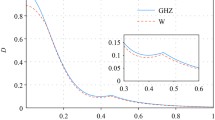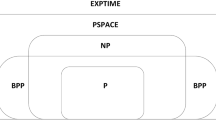Abstract
Bell non-locality and Kochen–Specker (KS) contextuality are logically independent concepts, fuel different protocols with quantum vs classical advantage, and have distinct classical simulation costs. A natural question is what are the relations between these concepts, advantages, and costs. To address this question, it is useful to have a map that captures all the connections between Bell non-locality and KS contextuality in quantum theory. The aim of this work is to introduce such a map. After defining the theory-independent notions of Bell non-locality and KS contextuality for ideal measurements, we show that, in quantum theory, due to Neumark’s dilation theorem, every quantum Bell non-local behavior can be mapped to a formally identical KS contextual behavior produced in a scenario with identical relations of compatibility but where measurements are ideal and no space-like separation is required. A more difficult problem is identifying connections in the opposite direction. We show that there are “one-to-one” and partial connections between KS contextual behaviors and Bell non-local behaviors for some KS scenarios, but not for all of them. However, there is also a method that transforms any KS contextual behavior for quantum systems of dimension d into a Bell non-local behavior between two quantum subsystems each of them of dimension d. We collect all these connections in map and list some problems which can benefit from this map.


Similar content being viewed by others
References
Bell, J.S.: On the Einstein Podolsky Rosen paradox. Physics 1, 195 (1964)
Clauser, J.F., Horne, M.A., Shimony, A., Holt, R.A.: Proposed experiment to test local hidden-variable theories. Phys. Rev. Lett. 23, 880 (1969)
Brunner, N., Cavalcanti, D., Pironio, S., Scarani, V., Wehner, S.: Bell nonlocality. Rev. Mod. Phys. 86, 419 (2014)
Specker, E. P.: Die Logik nicht gleichzeitig entscheidbarer Aussagen, Dialectica 14, 239 (1960) [English version: the logic of non-simultaneously decidable propositions, arXiv:1103.4537.]
Bell, J.S.: On the problem of hidden variables in quantum mechanics. Rev. Mod. Phys. 38, 447 (1966)
Kochen, S., Specker, E.P.: The problem of hidden variables in quantum mechanics. J. Math. Mech. 17, 59 (1967)
Klyachko, A.A., Can, M.A., Binicioğlu, S., Shumovsky, A.S.: Simple test for hidden variables in spin-1 systems. Phys. Rev. Lett. 101, 020403 (2008)
Cabello, A.: Experimentally testable state-independent quantum contextuality. Phys. Rev. Lett. 101, 210401 (2008)
Cabello, A.: Quantum correlations from simple assumptions. Phys. Rev. A 100, 032120 (2019)
Barrett, J., Kent, A.: Non-contextuality, finite precision measurement and the Kochen–Specker theorem. Stud. Hist. Philos. Sci. B Stud. Hist. Philos. Modern Phys. 35, 151 (2004)
Kleinmann, M.: Sequences of projective measurements in generalized probabilistic models. J. Phys. A Math. Theor. 47, 455304 (2014)
Chiribella, G., Yuan, X.: Measurement sharpness cuts nonlocality and contextuality in every physical theory. arXiv:1404.3348
Chiribella, G., Yuan, X.: Bridging the gap between general probabilistic theories and the device-independent framework for nonlocality and contextuality. Inf. Comput. 250, 15 (2016)
Ekert, A.K.: Quantum cryptography based on Bell’s theorem. Phys. Rev. Lett. 67, 661 (1991)
Barrett, J., Hardy, L., Kent, A.: No signaling and quantum key distribution. Phys. Rev. Lett. 95, 010503 (2005)
Acín, A., Brunner, N., Gisin, N., Massar, S., Pironio, S., Scarani, V.: Device-independent security of quantum cryptography against collective attacks. Phys. Rev. Lett. 98, 230501 (2007)
Brukner, Č., Żukowski, M., Pan, J.-W., Zeilinger, A.: Bell’s inequalities and quantum communication complexity. Phys. Rev. Lett. 92, 127901 (2004)
Colbeck, R.: Quantum and Relativistic Protocols for Secure Multi-Party Computation, Ph.D. thesis, University of Cambridge (2006). arXiv:0911.3814
Pironio, S., Acín, A., Massar, S., de la Giroday, A.B., Matsukevich, D. N., Maunz, P., Olmschenk, S., Hayes, D., Luo, L., Manning, T. A., Monroe, C., : Random numbers certified by Bell’s theorem. Nature (London) 464, 1021 (2010)
Summers, S.J., Werner, R.: Maximal violation of Bell’s inequalities is generic in quantum field theory. Commun. Math. Phys. 110, 247 (1987)
Popescu, S., Rohrlich, D.: Which states violate Bell’s inequality maximally? Phys. Lett. A 169, 411 (1992)
Mayers, D., Yao, A.: Quantum cryptography with imperfect apparatus. In: Proceedings 39th Annual Symposium on Foundations of Computer Science, p. 503. Los Alamitos, CA, IEEE (1998)
Howard, M., Wallman, J., Veitch, V., Emerson, J.: Contextuality supplies the ‘magic’ for quantum computation. Nature (London) 510, 351 (2014)
Delfosse, N., Guerin, P.A., Bian, J., Raussendorf, R.: Wigner function negativity and contextuality in quantum computation on rebits. Phys. Rev. X 5, 021003 (2015)
Raussendorf, R., Browne, D.E., Delfosse, N., Okay, C., Bermejo-Vega, J.: Contextuality as a resource for models of quantum computation with qubits. Phys. Rev. Lett. 119, 120505 (2017)
Bravyi, S., Gosset, D., König, R.: Quantum advantage with shallow circuits. Science 362, 308 (2018)
Maudlin, T.: Bell’s inequality, information transmission, and prism models. In: Hull, D., Forbes, M., and Okruhlik, K. (eds) PSA: Proceedings of the Biennial Meeting of the Philosophy of Science Association, vol. 1992, p. 404. Philosophy of Science Association, East Lansing, MI (1992)
Brassard, G., Cleve, R., Tapp, A.: Cost of exactly simulating quantum entanglement with classical communication. Phys. Rev. Lett. 83, 1874 (1999)
Toner, B.F., Bacon, D.: Communication cost of simulating Bell correlations. Phys. Rev. Lett. 91, 187904 (2003)
Kleinmann, M., Gühne, O., Portillo, J.R., Larsson, J.-Å., Cabello, A.: Memory cost of quantum contextuality. New J. Phys. 13, 113011 (2011)
Cabello, A., Gu, M., Gühne, O., Xu, Z.-P.: Optimal classical simulation of state-independent quantum contextuality. Phys. Rev. Lett. 120, 130401 (2018)
Budroni, C.: Contextuality, memory cost and non-classicality for sequential measurements. Philos. Trans. A 377, 20190141 (2019)
Cabello, A., Gu, M., Gühne, O., Larsson, J.-Å., Wiesner, K.: Thermodynamical cost of some interpretations of quantum theory. Phys. Rev. A 94, 052127 (2016)
Cabello, A.: "All versus nothing" inseparability for two observers. Phys. Rev. Lett. 87, 010403 (2001)
Cabello, A.: Proposal for revealing quantum nonlocality via local contextuality. Phys. Rev. Lett. 104, 220401 (2010)
Aolita, L., Gallego, R., Acín, A., Chiuri, A., Vallone, G., Mataloni, P., Cabello, A.: Fully nonlocal quantum correlations. Phys. Rev. A 85, 032107 (2012)
Cabello, A., Amselem, E., Blanchfield, K., Bourennane, M., Bengtsson, I.: Proposed experiments of qutrit state-independent contextuality and two-qutrit contextuality-based nonlocality. Phys. Rev. A 85, 032108 (2012)
Liu, B.-H., Hu, X.-M., Chen, J.-S., Huang, Y.-F., Han, Y.-J., Li, C.-F., Guo, G.-C., Cabello, A.: Nonlocality from local contextuality. Phys. Rev. Lett. 117, 220402 (2016)
Suarez, A.: All-possible-worlds: Unifying many-worlds and Copenhagen, in the light of quantum contextuality. arXiv:1712.06448
Peres, A.: Incompatible results of quantum measurements. Phys. Lett. A 151, 107 (1990)
Mermin, N.D.: Simple unified form for the major no-hidden-variables theorems. Phys. Rev. Lett. 65, 3373 (1990)
Neumark, M. A.: On the self-adjoint extensions of the second kind of a symmetric operator, Izv. Akad. Nauk S.S.S.R. [Bull. Acad. Sci. U.S.S.R.] Sér. Mat. 4, 53 (1940) (Russian with English summary); Spectral functions of a symmetric operator, Izv. Akad. Nauk S.S.S.R. [Bull. Acad. Sci. U.S.S.R.] Sér. Mat. 4, 277 (1940) (Russian with English summary); On a representation of additive operator set functions, C.R. (Dokl.) Acad. Sci. U.R.S.S. (N.S.) 41, 359 (1943)
Holevo, A.S.: Probabilistic and Statistical Aspects of Quantum Theory, p. 55. Scuola Normale Superiore Pisa, Pisa (2011)
Peres, A.: Quantum Theory: Concepts and Methods, p. 285. Kluwer, New York (1995)
Froissart, M.: Constructive generalization of Bell’s inequalities. Nuov. Cim. B 64, 241 (1981)
Suppes, P., Zanotti, M.: When are probabilistic explanations possible? Synthese 48, 191 (1981)
Fine, A.: Joint distributions, quantum correlations, and commuting observables. J. Math. Phys. 23, 1306 (1982)
Fine, A.: Hidden variables, joint probability, and the Bell inequalities. Phys. Rev. Lett. 48, 291 (1982)
Pitowsky, I.: Quantum Probability-Quantum Logic. Lecture Notes in Physics. Springer, Berlin (1989)
Kleinmann, M., Budroni, C., Larsson, J.-Å., Gühne, O., Cabello, A.: Optimal inequalities for state-independent contextuality. Phys. Rev. Lett. 109, 250402 (2012)
Araújo, M., Quintino, M.T., Budroni, C., Cunha, M.Terra, Cabello, A.: All noncontextuality inequalities for the n-cycle scenario. Phys. Rev. A 88, 022118 (2013)
Michler, M., Weinfurter, H., Żukowski, M.: Experiments towards falsification of noncontextual hidden variable theories. Phys. Rev. Lett. 84, 5457 (2000)
Hasegawa, Y., Loidl, R., Badurek, G., Baron, M., Rauch, H.: Violation of a Bell-like inequality in single-neutron interferometry. Nature (London) 425, 45 (2003)
Pearle, P.M.: Hidden-variable example based upon data rejection. Phys. Rev. D 2, 1418 (1970)
Braunstein, S.L., Caves, C.M.: Wringing out better Bell inequalities. Ann. Phys. 202, 22 (1990)
Boschi, D., Branca, S., De Martini, F., Hardy, L.: Ladder proof of nonlocality without inequalities: theoretical and experimental results. Phys. Rev. Lett. 79, 2755 (1997)
Xu, Z.-P., Cabello, A.: Quantum correlations with a gap between the sequential and spatial cases. Phys. Rev. A 96, 012127 (2017)
Cabello, A.: Converting contextuality into nonlocality. arXiv:2011.13790
Badzia̧g, P., Bengtsson, I., Cabello, A., Pitowsky, I.: Universality of State-independent violation of correlation inequalities for noncontextual theories. Phys. Rev. Lett. 103, 050401 (2009)
Yu, S., Oh, C.H.: State-independent proof of Kochen–Specker Theorem with 13 rays. Phys. Rev. Lett. 108, 030402 (2012)
Cabello, A., Kleinmann, M., Budroni, C.: Necessary and sufficient condition for quantum state-independent contextuality. Phys. Rev. Lett. 114, 250402 (2015)
Amaral, B., Cunha, M.Terra, Cabello, A.: Quantum theory allows for absolute maximal contextuality. Phys. Rev. A 92, 062125 (2015)
Cabello, A., Severini, S., Winter, A.: Graph-theoretic approach to quantum correlations. Phys. Rev. Lett. 112, 040401 (2014)
Grudka, A., Horodecki, K., Horodecki, M., Horodecki, P., Horodecki, R., Joshi, P., Kłobus, W., Wójcik, A.: Quantifying contextuality. Phys. Rev. Lett. 112, 120401 (2014)
Bharti, K., Ray, M., Varvitsiotis, A., Warsi, N.A., Cabello, A., Kwek, L.-C.: Robust self-testing of quantum systems via noncontextuality inequalities. Phys. Rev. Lett. 122, 250403 (2019)
Acknowledgements
The author thanks Matthew Pusey and Zhen-Peng Xu for comments on an earlier version of this work. This work was supported by Project Qdisc (Project No. US-15097), with FEDER funds, MINECO Project No. FIS2017-89609-P, with FEDER funds, and QuantERA Grant SECRET, by MINECO (Project No. PCI2019-111885-2).
Author information
Authors and Affiliations
Corresponding author
Additional information
Publisher's Note
Springer Nature remains neutral with regard to jurisdictional claims in published maps and institutional affiliations.
Rights and permissions
About this article
Cite this article
Cabello, A. Bell Non-locality and Kochen–Specker Contextuality: How are They Connected?. Found Phys 51, 61 (2021). https://doi.org/10.1007/s10701-021-00466-5
Received:
Accepted:
Published:
DOI: https://doi.org/10.1007/s10701-021-00466-5




